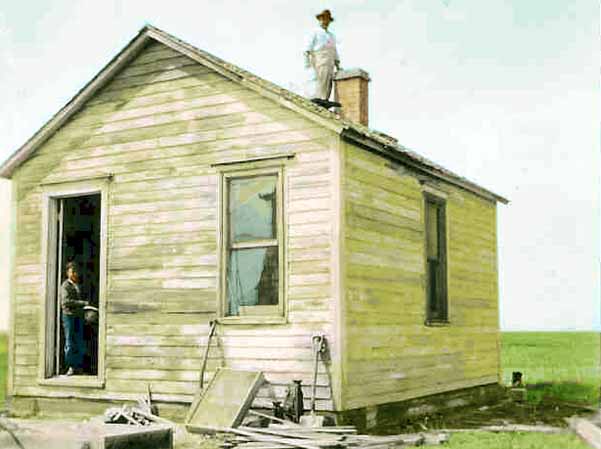
Completing Homesteader's house, Iowa Flats.
The first thing a homesteader had to do on arriving in Wyoming was to locate his claim. Usually the services of a "location man" was utilized.
A site would be located, Then the claim would be filed in the land office. The location man might might charge as much as
$25.00 to over $100 for his services. Charles A. Dalich noted in his "Dry Farming Promotion in eastern Montana (1907-1916), Univesity of Montana, 1968, p. 73:
When a Dutton homesteader inquired for a locator, a native replied, "Just go down the street and look like
a sucker and George Sollid will find you." Some land locators handled as many as five or six claims a day, making the occupation quite profitable.
The homesteader if did not already have a horse and wagon needed to purchase one and then construct his shelter.
For those who had money, the shelter might, as in the above image, be constructed of shiplap siding. Those with less money might construct the shelter from
tar paper. Water then had to be obtained. Although Charles Henry Bacon in his letter quoted on the
previous page indicated that a well on the Flats might be as deep as 100 feet. C. O. Downing's well was 236 feet deep.
In the above image note the reflection of
the windmill in the window. The windmill was used to pump water from a deep well. Downing used the services of
Charles N. Christy as a location man paying him $25.00. Christy like many on Iowa Flats came from Iowa. Downing was a newly minted
college graduate from New York.
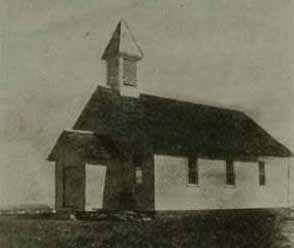 Iowa Flats Methodist Episcopal
Church, circa 1911 Iowa Flats Methodist Episcopal
Church, circa 1911
The homesteaders worked cooperatively. Thus they constructed their own school and church.
The church was founded in 1909 and met in Chugwater. Later until the church could be constructed, Sunday School was conducted in the
Frank Hanisch's barn. In 1910, Robert Kletzing donated land for the
church and a cemetery. One of the first interred in the cemetery was Minnie Warren and her daughter three-year old Opal. April 25, 1911, dawned bright. Minnie's husband
Lee had gone with his brothers to Pine Bluffs
to purchase seed oats for spring planting. The two older children had gone off to their grandparents' house connected by an
old Swan land company road. During the day a storm came in from the northwest. Minnie apparently decided that she should go to the
grandparents' house to meet the two older children in the event that they were on the way back. In the storm Minnie apparently mistook an old cattle track for
the road. When her husband came home late and not finding his wife and children he searched for them using a borrowed horse. Along side the
track on a prairie hill about a mile and a half from the grandparent's house the bodies of Minnie and Opal were found, Opal in her mother's arms and wrapped
in her mother's underskirt. Years later Lloyd Wilson who grew up on the flats commented that
the tragedy brought the community together, out on the prairie the homesteaders were dependent upon each other.
Other tragedies came to the Flats. Two-year old Vanita Baker wandered out of her house on a February night. Her parents could not find her.
Several days later her body was found. C. N. Christy's daughter died from petonitis as a result of
appendecitis. A few years before she had written her old class mates in Ottamuwa, Iowa describing
Iowa Flats. She commented on the number of rattlesnakes in the area, a comment also made by Lloyd Wilson. The Wilson's had come from
Oklahoma and the homestead was initially a half dugout.
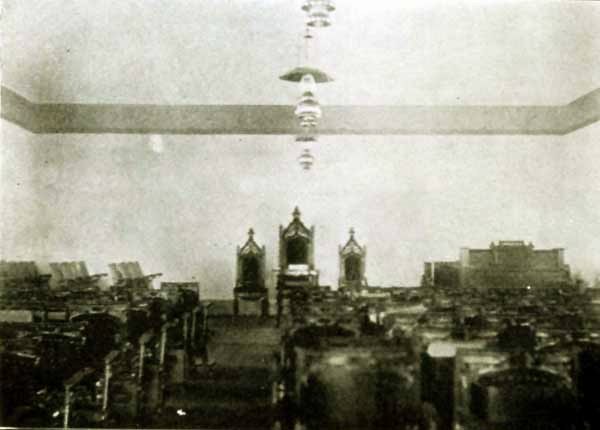
Iowa Flats Church interior, 1910.
The church cost $1,600 to construct.
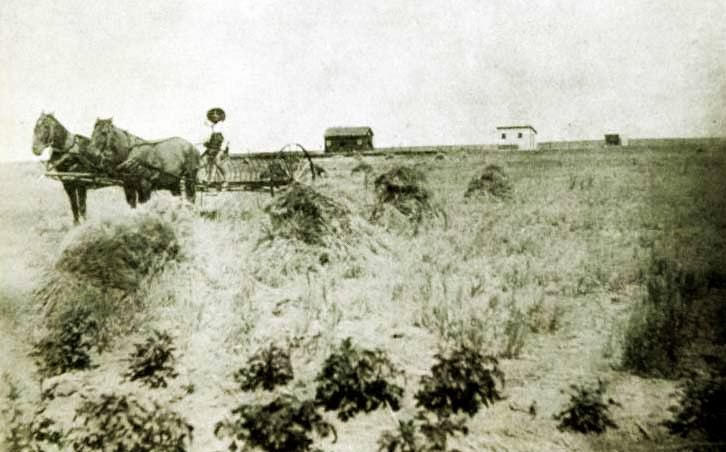
Frank Hanisch Homestead, Iowa Flats.
Frank Hanisch was originally from Bohemia, now a part of the Czech Republic and then a part of the
Austro-Hungarian Empire. There was a substantial number of Czech homesteaders on the Flats, many from Milligan, Nebraska. These included
Ed and Joseph Janousek, Rudy and James Krisl, Ed Stastny, E. A. Kotas and Emil Korbelik. Milligan was at the time regarded
as an almost entirely Czech town. Frank Hansch's barn was not the only barn used for meetings. Joe
Janousek's barn was a meeting place for Homestead No. 4170, Brotherhood of American Yeoman. The Yeoman was a fraternal order during the early year of the
Twentieth Century. Lodges were called "homesteads." In eastern Wyoming there were Yeoman Homesteads in Cheyenne, Carpenter, Hillsdale, Pine Bluffs, Burns, and Wheatland.
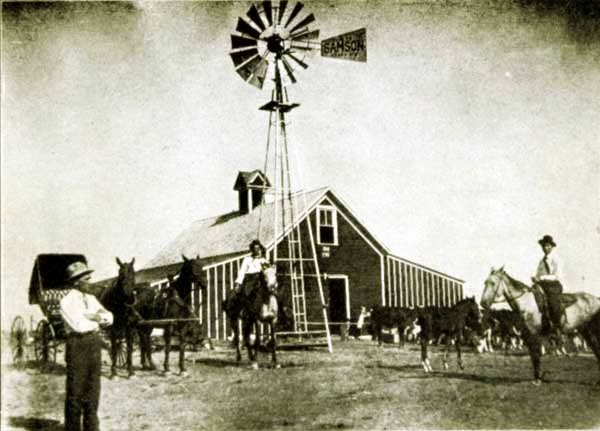
Joe Janousek's Barn, Iowa Flats. Joe is standing with arms folded in front of the buggy. Photo courtesy
Sharon Lawrence.
A complete set of Sharon Lawrence's photos may be viewed on the Wyoming State Archives's photographs website.
Joe's homestead was on the Platte County side of the Flats. Ed's was on the Goshen County side.
The growth on the flats can be illustrated by the following two
photos of the Fourth of July Picnics.
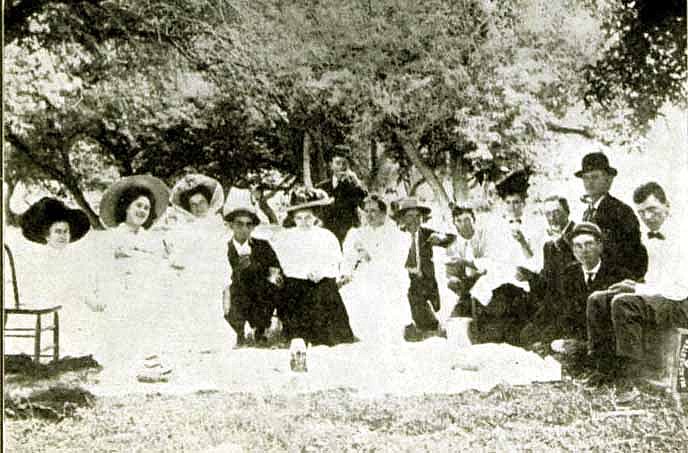
The Iowa Flats Fourth of July picnic, Box Elder Creek, 1909.
The picnic was held along Box Elder Creek whose drainage begins on the Flats. About 1910,
In 1012. Joe hosted a Fourth of July celebration on his homestead.
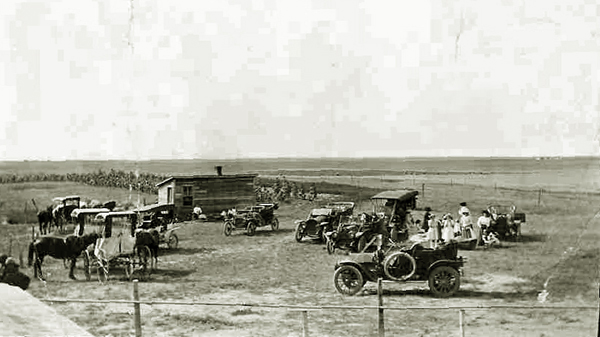
The photo is believed to be of the crowds for the Fourth of July celebratiion at Joe Janaousek's
homestead. Photo courtesy Sharon Lawrence.
The celebration included a baseball game and a wrestling match between
brothers Burrell and Wright Nickeson aged 11 and 10.
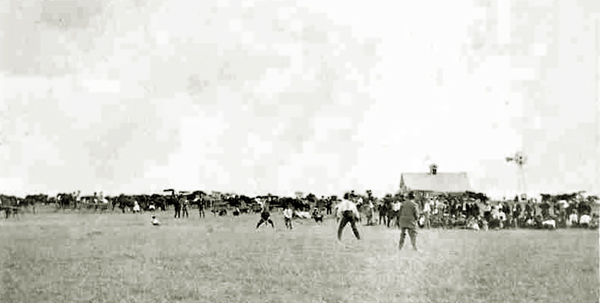
Iowa Flats Fourth of July baseball game, Joe Janousek's homestead, 1912. Photo courtesy Sharon Lawrence.
The Nickeson brothers were the sons of Virgil Clark Nickeson, Sr. (1871-1948).
The Nickesons came from Iowa. Virgil was a barber and in addition to farming the
homestead, operated a barbershop from a box car in Chugwater.
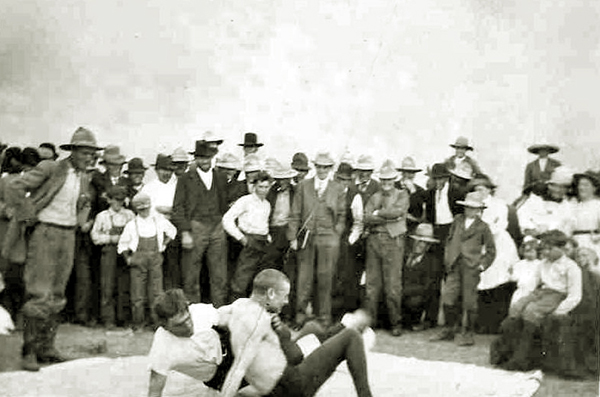
Wrestling Match between Nickeson Brothers. Photo courtesy Sharon Lawrence.
One of those who came from Milligan at the same time as the Janousek Brothers was
Emil Korbelik, Sr. (1875-1938) [Neither father nor son were the famed Emil Kobelik who played with the Math Sladkey
Czech Polka Band]. The senior Korbelik homesteaded 320 acres and played
a two-row button accordion.
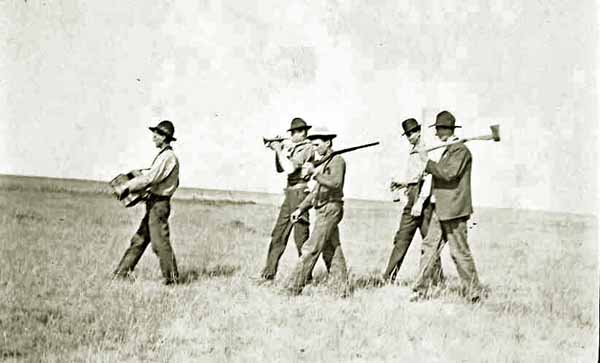
Iowa Flats Band led by two-row button accordian player, believed to be Emil Korbelik. Photo Courtesy Sharon Lawrence.
Music this page: Iowa State March as playing on an accordian, courtesy
Horse Creek Cowboy.
Next page: Iowa Flats continued.
|